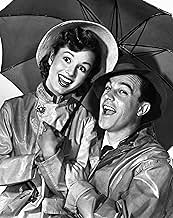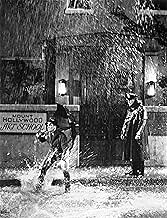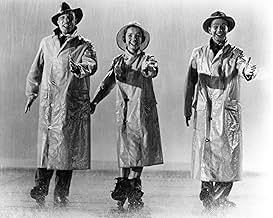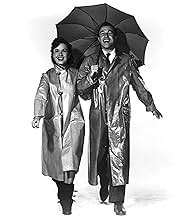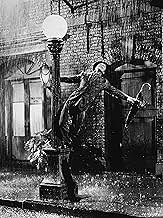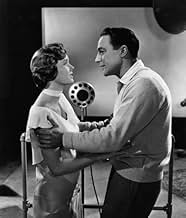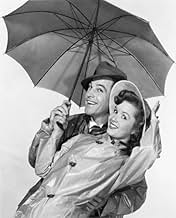Una società di produzione cinematografica muto e un cast fanno una difficile transizione verso il suono.Una società di produzione cinematografica muto e un cast fanno una difficile transizione verso il suono.Una società di produzione cinematografica muto e un cast fanno una difficile transizione verso il suono.
- Regia
- Sceneggiatura
- Star
- Candidato a 2 Oscar
- 11 vittorie e 11 candidature totali
Dawn Addams
- Teresa - a Lady-in-Waiting
- (non citato nei titoli originali)
John Albright
- Call Boy
- (non citato nei titoli originali)
Shirlee Allard
- Chorus Girl
- (non citato nei titoli originali)
Bebe Allen
- Chorus Girl
- (non citato nei titoli originali)
Sue Allen
- Chorus Girl
- (non citato nei titoli originali)
John Angelo
- Dancer
- (non citato nei titoli originali)
Marie Ardell
- Chorus Girl
- (non citato nei titoli originali)
Bette Arlen
- 'Miss January' in 'Beautiful Girl' segment
- (non citato nei titoli originali)
David Bair
- Chorus Boy
- (non citato nei titoli originali)
Jane Bateman
- Chorus Girl
- (non citato nei titoli originali)
Riepilogo
Reviewers say 'Singin' in the Rain' is a celebrated classic, praised for its charm, wit, and infectious energy. Gene Kelly's performance, especially in the title number, is lauded for its seamless blend of dancing, singing, and charisma. The supporting cast, including Debbie Reynolds and Donald O'Connor, is commended for their stellar performances and chemistry. The film's vibrant choreography, clever script, and memorable musical numbers are frequently celebrated. Despite minor criticisms about predictability and humor, it remains a beloved musical.
Recensioni in evidenza
One thing I noticed in reading the comments of this movie is that nobody recognized the screenplay by Betty Comden and Adolph Green. Without their screenplay the movie does not get made. It is a great script that was made better by Gene Kelly and Stanley Donens' fluid direction. Everything in this movie glides effortlessly. Throw in dancing by Donald O'connor, Debbie Reynolds, Cyd Charisse and of course Gene Kelly, Great songs and the willingness of producer Arthur Freed to let the creative people to do their thing and you have a classic.
Last year I was very lucky to catch this on the big screen. This film is meant to be seen on the big screen! It was also the first time I saw it at the theaters and I was very impressed with the visuals.
In this film movies are switching over from being silent to being "talkies". However the film is a spoof of the turmoil that afflicted the movie industry in the late 1920s when movies when the change over went from silent to sound. When two silent movie stars', Don Lockwood and Lina Lamont, latest movie is made into a musical a chorus girl is brought in to dub Lina's speaking and singing. Don is on top of the world until Lina finds out.
This is such a great film that if you ever get the chance to see this at the movies then DO IT.
Gene Kelly and Debbie Reynolds made an awesome team.
In this film movies are switching over from being silent to being "talkies". However the film is a spoof of the turmoil that afflicted the movie industry in the late 1920s when movies when the change over went from silent to sound. When two silent movie stars', Don Lockwood and Lina Lamont, latest movie is made into a musical a chorus girl is brought in to dub Lina's speaking and singing. Don is on top of the world until Lina finds out.
This is such a great film that if you ever get the chance to see this at the movies then DO IT.
Gene Kelly and Debbie Reynolds made an awesome team.
Everybody knows Gene Kelly singing and dancing in the films title number, but this is just one of the many magical musical numbers in this epic piece of blissful entertainment. Set during the turbulent period when Hollywood was converting from silent films to sound, Singin' in the Rain' is a perfect example of everything that is good and right about movie-making. Gene Kelly in his greatest role is an all singing, all dancing sensation and his acting is pretty damn good too. Donald O'Connor excels as his exuberant sidekick and almost steals the show with the unsurpassed Make em Laugh'. Debbie Reynolds is feisty and sexy as Kelly's love interest, while Jean Hagen gives one of the screen's greatest supporting performances as the horrid Lena Lamont, a silent screen goddess whose voice will just not cut it in talkies.
The musical numbers flow fast and furious as Gene and Donald perform amazing feats of choreography with Fit as a Fiddle' and Moses Supposes' while Good Mornin' will have you dancing in the aisles. If Singin' in the Rain' had no musical numbers it would still be a contender for the funniest film ever made. The problems with experiments with sound films are painfully funny, and Kelly's silent sparring with the demonic Hagen is hilarious. The accolade of sheer perfection can be conferred on few films, and such a title is perhaps even an understatement in this case. And never before did rain look like so much fun.
The musical numbers flow fast and furious as Gene and Donald perform amazing feats of choreography with Fit as a Fiddle' and Moses Supposes' while Good Mornin' will have you dancing in the aisles. If Singin' in the Rain' had no musical numbers it would still be a contender for the funniest film ever made. The problems with experiments with sound films are painfully funny, and Kelly's silent sparring with the demonic Hagen is hilarious. The accolade of sheer perfection can be conferred on few films, and such a title is perhaps even an understatement in this case. And never before did rain look like so much fun.
Singin' in the Rain is one of the best movies ever made. The film is beautiful, tuneful, and loads of fun. While it pokes fun at Hollywood it also does so with great love. Little bits and pieces of Hollywood lore find their way into this great film and it's a pleasure to get the joke or recognize the real star they're referring to.
The star trio is just perfect: Gene Kelly give a funny performance as the hammy silent actor; Donald O'Connor makes the most of his "second banana" role; Debbie Reynolds is perfect as the ingénue trying to break into films.
The three stars perform many memorable numbers, including Kelly's "Singin' in the Rain" classic; all three in the "Good Mornin'" number; O'Connor's "Make 'Em Laugh"; and Kelly and Reynolds in "You Were Meant for Me." The masterpiece however may be the "Gotta Dance" production number with Kelly and Cyd Charissejust perfect. Also great fun are O'Connor and Kelly in "Fit as a Fiddle" and "Moses Supposes."
There are of course other production numbers, including the montage that shows Hollywood's race to transition to talkies, a scene that ends in the "Beautiful Girl" number featuring Jimmy Thompson.
Jean Hagen (as Lina Lamont) won an Oscar nomination and steals the film in a classic comedy performance. Also good are Millard Mitchell, Douglas Fowley, Rita Moreno, King Donovan, Kathleen Freeman, Mae Clarke, Julius Tannen, and Madge Blake.
The great trick to this film is that while Reynolds is supposedly "lip syncing" for Hagen, it's really Hagen's voice that Reynolds is miming to as in the "I Would, Would You" number. The final miming act is Hagen mouthing "Singin' in the Rain" is really Reynolds. It gets so confusing you can't tell who is lip syncing whose voice.
Lots of Hollywood lore retold in this film. Hagen's Lamont character is a veiled reference to Norma Talmadge, who supposedly failed in talkies because of her New York accent. It's also a reference to Louise Brooks, whose talkie debut in The Canary Murder Case was all dubbed. When Kelly screams "I LOVE YOU" it's a reference to John Gilbert in is talkie debut flop. His Glorious Night. Kathleen Freeman's diction coach character is a reference to Constance Collier, who returned to Hollywood as a coach. And on it goes.
A great film!
The star trio is just perfect: Gene Kelly give a funny performance as the hammy silent actor; Donald O'Connor makes the most of his "second banana" role; Debbie Reynolds is perfect as the ingénue trying to break into films.
The three stars perform many memorable numbers, including Kelly's "Singin' in the Rain" classic; all three in the "Good Mornin'" number; O'Connor's "Make 'Em Laugh"; and Kelly and Reynolds in "You Were Meant for Me." The masterpiece however may be the "Gotta Dance" production number with Kelly and Cyd Charissejust perfect. Also great fun are O'Connor and Kelly in "Fit as a Fiddle" and "Moses Supposes."
There are of course other production numbers, including the montage that shows Hollywood's race to transition to talkies, a scene that ends in the "Beautiful Girl" number featuring Jimmy Thompson.
Jean Hagen (as Lina Lamont) won an Oscar nomination and steals the film in a classic comedy performance. Also good are Millard Mitchell, Douglas Fowley, Rita Moreno, King Donovan, Kathleen Freeman, Mae Clarke, Julius Tannen, and Madge Blake.
The great trick to this film is that while Reynolds is supposedly "lip syncing" for Hagen, it's really Hagen's voice that Reynolds is miming to as in the "I Would, Would You" number. The final miming act is Hagen mouthing "Singin' in the Rain" is really Reynolds. It gets so confusing you can't tell who is lip syncing whose voice.
Lots of Hollywood lore retold in this film. Hagen's Lamont character is a veiled reference to Norma Talmadge, who supposedly failed in talkies because of her New York accent. It's also a reference to Louise Brooks, whose talkie debut in The Canary Murder Case was all dubbed. When Kelly screams "I LOVE YOU" it's a reference to John Gilbert in is talkie debut flop. His Glorious Night. Kathleen Freeman's diction coach character is a reference to Constance Collier, who returned to Hollywood as a coach. And on it goes.
A great film!
I don't like musicals. They never made any sense to me. Don't get me wrong, I love music; it's an important part of my life. I love movies also, and while the two often compliment each other, sometimes I'm repelled. It's probably the dancing. A person breaking into a complicated dance number, seemingly unaware of their surroundings, or worse yet, in complete synch with a complete stranger is like making fun of the movie, as if to say, "Please don't take us seriously, we like to sing and dance." Or even more ridiculous, "Let's not fight, let's settle this dispute with a song and dance." Forget about suspension of disbelief.
This film however, I manage to enjoy. I once was given the task of my film teacher to watch the film and keep track of all the cuts in the film. Well, sometime after ten minutes I lost track because I was so wrapped up in the story. It really is an interesting period in the history of cinema, told well, and with well placed song and dance numbers that at times drag on, but that seems to be more of an excuse to show off the technicolour than anything else. They build you up to it slowly. The first few numbers don't break out at an inappropriate time. It doesn't last though, but by then they've got you.
With such memorable tunes as these, it's hard to imagine them going wrong. When Gene Kelly sings the title piece, somehow time stands still as you're swept up in one of the most memorable scenes in film history. Just reading the title in print has likely caused you to hum a few bars, or sing a few words. Or maybe, just maybe, walk out without an umbrella when you know it's raining. One thing's for sure, if all Gene Kelly did was choreograph the dance numbers, he more than deserves the co-directing credit he has.
They simply don't make films like this anymore. Which in some ways is a testament to the film's theme and narrative. The business of show is constantly in a state of evolution. The narrative portrays a time period when silent films were being replaced by "talkies" with sound, yet the musical genre itself has almost all but disappeared with the exception of animated films with musical numbers, and rare live-action pieces.
One might speculate that Hollywood overdid the musical. Personally, I can't get into them. Most of the time it seems like a drawn out affair, but this film is something special. Considering my feelings about musicals, it would have to take a film of this one's caliber to make me sit up and take notice.
This film however, I manage to enjoy. I once was given the task of my film teacher to watch the film and keep track of all the cuts in the film. Well, sometime after ten minutes I lost track because I was so wrapped up in the story. It really is an interesting period in the history of cinema, told well, and with well placed song and dance numbers that at times drag on, but that seems to be more of an excuse to show off the technicolour than anything else. They build you up to it slowly. The first few numbers don't break out at an inappropriate time. It doesn't last though, but by then they've got you.
With such memorable tunes as these, it's hard to imagine them going wrong. When Gene Kelly sings the title piece, somehow time stands still as you're swept up in one of the most memorable scenes in film history. Just reading the title in print has likely caused you to hum a few bars, or sing a few words. Or maybe, just maybe, walk out without an umbrella when you know it's raining. One thing's for sure, if all Gene Kelly did was choreograph the dance numbers, he more than deserves the co-directing credit he has.
They simply don't make films like this anymore. Which in some ways is a testament to the film's theme and narrative. The business of show is constantly in a state of evolution. The narrative portrays a time period when silent films were being replaced by "talkies" with sound, yet the musical genre itself has almost all but disappeared with the exception of animated films with musical numbers, and rare live-action pieces.
One might speculate that Hollywood overdid the musical. Personally, I can't get into them. Most of the time it seems like a drawn out affair, but this film is something special. Considering my feelings about musicals, it would have to take a film of this one's caliber to make me sit up and take notice.
Lo sapevi?
- QuizFor the "Make 'em Laugh" number, Donald O'Connor revived a trick he had done as a young dancer: running up a wall and completing a somersault. The number was so physically taxing that O'Connor ended up in a hospital bed for a week after its completion. He suffered from exhaustion and carpet burns. After an accident ruined all of the initial footage, O'Connor agreed to do the difficult number all over again.
- BlooperDuring the Cyd Charisse nightclub dance number, when she's wrapped around Gene Kelly, her body completely changes position between frames due to a clumsy edit. According to commentary on the special edition DVD, this cut of only a few frames' duration dates back to the original release of the film and no one knows why it exists.
- Citazioni
Cosmo Brown: Lina. She can't act, she can't sing, she can't dance. A triple threat.
- ConnessioniEdited from I tre moschettieri (1948)
- Colonne sonoreFit as a Fiddle
(1932)
Music by Al Hoffman (uncredited) and Al Goodhart (uncredited)
Lyrics by Arthur Freed
Originally from the 1932 stage revue "George White's Music Hall Varieties"
Sung by Gene Kelly (uncredited) and Donald O'Connor (uncredited)
I più visti
Accedi per valutare e creare un elenco di titoli salvati per ottenere consigli personalizzati
Dettagli
- Data di uscita
- Paese di origine
- Lingua
- Celebre anche come
- Cantando bajo la lluvia
- Luoghi delle riprese
- Azienda produttrice
- Vedi altri crediti dell’azienda su IMDbPro
Botteghino
- Budget
- 2.540.800 USD (previsto)
- Lordo Stati Uniti e Canada
- 1.884.537 USD
- Fine settimana di apertura Stati Uniti e Canada
- 13.643 USD
- 10 nov 2002
- Lordo in tutto il mondo
- 2.096.442 USD
- Tempo di esecuzione
- 1h 43min(103 min)
- Colore
- Mix di suoni
- Proporzioni
- 1.37 : 1
Contribuisci a questa pagina
Suggerisci una modifica o aggiungi i contenuti mancanti








